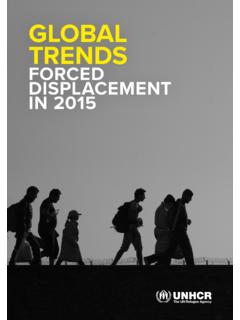Transcription of Beyond GDP? Welfare across Countries and Time
1 American Economic Review 2016, 106(9): 2426 2457 GDP? Welfare across Countries and Time By Charles I. Jones and Peter J. Klenow*We propose a summary statistic for the economic well-being of people in a country. Our measure incorporates consumption, leisure, mortality, and inequality, first for a narrow set of Countries using detailed micro data, and then more broadly using multi-country datasets. While Welfare is highly correlated with GDP per capita, deviations are often large. Western Europe looks considerably closer to the United States, emerging Asia has not caught up as much, and many developing Countries are further behind. Each component we introduce plays a significant role in accounting for these differences, with mortality being most important.
2 (JEL D63, E21, E23, E24, I12, O57)As many economists have noted, GDP is a flawed measure of economic Welfare . Leisure, inequality, mortality, morbidity, crime, and the natural environment are just some of the major factors affecting living standards within a country that are incor-porated imperfectly, if at all, in GDP. The Stiglitz Commission Report (Stiglitz, Sen, and Fitoussi 2009) was the latest attempt to sort through the criticisms of GDP and seek practical recommendations for improvement. Though there are significant conceptual and empirical hurdles to including some of these factors in a Welfare measure, standard economic analysis is arguably well-equipped to deal with several of propose a simple summary statistic for the Welfare of a country s population, measured as a consumption equivalent, and compute its level and growth rate for a diverse set of Countries .
3 This Welfare measure combines data on consumption, lei-sure, inequality, and mortality using the standard economics of expected utility. The focus on consumption-equivalent Welfare follows in the tradition of Lucas (1987), who calculated the Welfare benefits of eliminating business cycles versus raising the growth an example, suppose we wish to compare living standards in France and the United States. GDP per person is markedly lower in France: France had a per capita * Jones: Graduate School of Business, Stanford University, 655 Knight Way, Stanford, CA 94305, and NBER (e-mail: Klenow: Department of Economics, Stanford University, Stanford, CA 94305, and NBER (e-mail: We are grateful to Mark Aguiar, Romans Pancs, Luigi Pistaferri, David Romer, David Weil, Alwyn Young, and many seminar participants for helpful comments, to David Laibson for a conversation that inspired this project, and to Gabriela Calderon, Siddharth Kothari, Jihee Kim, Huiyu Li, Alejandro Molnar, Ariana Poursartip, Rui Xu, and Zhen (Zachary) Yan for excellent research assistance.))
4 The authors declare that they have no relevant or material financial interests that relate to the research described in this paper. Go to to visit the article page for additional materials and author disclosure statement(s).2427 JONES AND KLENOW: Welfare across Countries AND TIMEVOL. 106 NO. 9 GDP in 2005 equal to just 67 percent of the US value. Consumption per person in France was even lower only 60 percent of the United States, even adding govern-ment consumption to private consumption. However, other indicators looked better in France. Life expectancy at birth was around 80 years in France versus 77 years in the United States. Leisure was higher in France: Americans worked 877 hours (per person, not per worker) versus only 535 hours for the French.
5 Inequality was substantially lower in France: the standard deviation of log consumption was around in the United States but only in Welfare metric combines each of these factors with the level of consumption using an expected utility framework. We do this in two ways. First, we use detailed micro data from household surveys for 13 Countries to provide a measure of Welfare with as few assumptions as possible. Then, we use publicly available multi-country datasets to construct cruder Welfare measures for 152 Countries . Cross-checking these macro results with the detailed micro results suggests that there is valu-able information even using the coarse multi-country consumption-equivalent measure aims to answer questions such as: what proportion of consumption in the United States, given the US values of leisure, mortality, and inequality, would deliver the same expected utility as the values in France?
6 In our results, lower mortality, lower inequality, and higher leisure each add roughly 10 percentage points to French Welfare in terms of equivalent consumption. Rather than looking like 60 percent of the US value, as it does based solely on con-sumption, France ends up with consumption-equivalent Welfare equal to 92 percent of that in the United French example applies more broadly to Western Europe as a whole, but for the poorer Countries of the world, the opposite is typically true. Because of lower life expectancy and higher inequality, their consumption equivalent Welfare is often less than their income: Western Europe is closer to the United States, but poor and middle-income Countries are typically further behind. More generally, our findings can be summarized as follows: (i) GDP per person is an informative indicator of Welfare across a broad range of Countries : the two measures have a correlation of Nevertheless, there are economically important differences between GDP per person and consumption-equivalent Welfare .
7 across our 13 Countries , the median deviation is around 35 percent so disparities like we see in France are quite common. (ii) Average Western European living standards appear much closer to those in the United States (around 85 percent for Welfare versus 67 percent for income) when we take into account Europe s longer life expectancy, addi-tional leisure time, and lower inequality. (iii) Most developing Countries including much of sub-Saharan Africa, Latin America, southern Asia, and China are substantially poorer than incomes 1 Our calculations do not conflict with Prescott s (2004) argument that Americans work more than Europeans because of lower marginal tax rates in the United States.
8 The higher leisure in France partially compensates for their lower consumption. 2428 THE AMERICAN ECONOMIC REVIEWSEPTEMBER 2016suggest because of a combination of shorter lives and extreme inequality. Lower life expectancy reduces Welfare by 15 to 50 percent in the developing Countries we examine. Combined with the previous finding, the upshot is that, across Countries , Welfare inequality appears even greater than income inequality. (iv) Growth rates are typically revised upward, with Welfare growth averaging percent between the 1980s and the mid-2000s versus income growth of percent. A boost from rising life expectancy of more than a percentage point shows up throughout the world, with the notable exception of sub-Sa-haran Africa.
9 When Welfare grows 3 percent instead of 2 percent per year, living standards double in 24 years instead of 36 years; over a century, this leads to a 20-fold increase rather than a 7-fold US-France comparison, and our results for other Countries , emphasize an important point. High hours worked per capita and a high investment rate are well-known to deliver high GDP per capita, other things being equal. But these strategies have associated costs that are not reflected in GDP. Our Welfare measure values the high GDP but adjusts for the lower leisure and lower consumption share to produce a more complete picture of living paper builds on a large collection of related work. Nordhaus and Tobin (1972) introduced a Measure of Economic Welfare that combines consumption and leisure, values household work, and deducts urban disamenities for the United States over time.
10 We incorporate life expectancy and inequality and make compari-sons across Countries as well as over time, but we do not attempt to account for urban disamenities. The United Nations Human Development Index combines income, life expectancy, and literacy, first putting each variable on a scale from zero to one and then averaging. In comparison, we combine different ingredients (consumption rather than income, leisure rather than literacy, plus inequality) using a utility function to arrive at a consumption-equivalent Welfare measure that can be compared across time for a given country as well as across Countries . Ravallion (2012) criticizes mashup indices like the Human Development Index for their arbitrary nature; our approach is explicitly grounded in economic theory.









